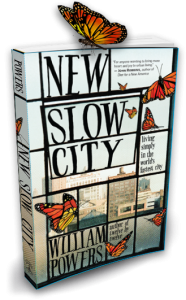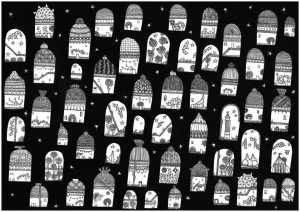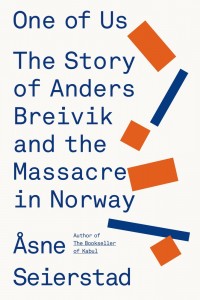Urban Pilgrim
 I am intrigued by the title of an article I ran across in the BCBS Insight Journal, “Urban Hermit: A Different Way of Being in the World.” While I love the idea of living like a modern-day Thoreau, in a sweet little cabin somewhere off in the woods, I’m pretty sure the reality of it would totally do me in…unless, of course, it was a very cushy cabin…with a nice, clean, flush toilet…and no mice, or snakes, or bugs!
I am intrigued by the title of an article I ran across in the BCBS Insight Journal, “Urban Hermit: A Different Way of Being in the World.” While I love the idea of living like a modern-day Thoreau, in a sweet little cabin somewhere off in the woods, I’m pretty sure the reality of it would totally do me in…unless, of course, it was a very cushy cabin…with a nice, clean, flush toilet…and no mice, or snakes, or bugs!
Also, I would want to have access to meaningful, human interaction on a regular basis (as Thoreau did), and to books and to the world of ideas, so this cushy little cabin would have to be within walking distance of a coffee shop. And maybe a diner. And there’d have to be internet access, of course.
So it gets complicated.
I value time alone, but I don’t really want to be a hermit.
I love simplicity, but I know that everything depends on everything else…which makes life complex.
So instead of being an Urban Hermit, I think I want to be an Urban Pilgrim. I want to live in an urban environment, but I don’t want to withdraw into it. I want to live this life as an intentional journey. Looking outward as well as in. With time alone. But also with fellow travelers. And I want to travel as lightly as I can.
So…I’m going to check out a book mentioned in the article, which also has a title that intrigues me. New Slow City: Living Simply in the World’s Fastest City, by William Powers (2014). It’s an account of how he and his wife “jettisoned 80 percent of their belongings and moved from their 2,000-square-foot townhouse in Queens, across the river to a 350-square-foot micro-apartment in Greenwich Village. It chronicles their attempt to live slowly and mindfully in frantic Manhattan.”
Sounds like a great little guide book!
Coming and Going
 My brother and his wife are coming to St. Louis tomorrow to stay with me for a few days, and then I’m going out of town again…this time to attend another Community Dharma Leader (CDL) training retreat. I get back on April 28, but won’t be posting until May 2. Check back then.
My brother and his wife are coming to St. Louis tomorrow to stay with me for a few days, and then I’m going out of town again…this time to attend another Community Dharma Leader (CDL) training retreat. I get back on April 28, but won’t be posting until May 2. Check back then.
In the mean time, I leave you with this selection from Invisible Cities, by Italo Calvino. It’s my favorite “travel guide,” which I always consult whenever I leave–or return–home.
Cities & Eyes: 4
When you have arrived at Phyllis, you rejoice in observing all the bridges over the canals, each different from the others: cambered, covered, on pillars, on barges, suspended, with tracery balustrades. And what a variety of windows looks down on the streets: mullioned, Moorish, lancet, pointed, surmounted by lunettes or stained-glass roses; how many kinds of pavement cover the ground: cobbles, slabs, gravel, blue and white tiles. At every point the city offers surprises to your view: a caper bush jutting from the fortress’ walls, the statues of three queens on corbels, an onion dome with three smaller onions threaded on the spire.
“Happy the one who has Phyllis before their eyes each day and who never ceases seeing the things it contains,” you cry, with regret at having to leave the city when you can barely graze it with your glance.
But it so happens that, instead, you must stay in Phyllis and spend the rest of your days there. Soon the city fades before your eyes, the rose windows are expunged, the statues on the corbels, the domes. Like all of Phyllis’s inhabitants, you follow zigzag lines from one street to another, you distinguish the patches of sunlight from the patches of shade, a door here, a stairway there, a bench where you can put down your basket, a hole where your foot stumbles if you are not careful. All the rest of the city is invisible. Phyllis is a space in which routes are drawn between points suspended in the void: the shortest way to reach that certain merchant’s tent, avoiding that certain creditor’s window. Your footsteps follow not what is outside the eyes, but what is within, buried, erased. If, of two arcades, one continues to seem more joyous, it is because thirty years ago a girl went by there, with broad, embroidered sleeves, or else it is only because that arcade catches the light at a certain hour like that other arcade, you cannot recall where.
Millions of eyes look up at windows, bridges, capers, and they might be scanning a blank page. Many are the cities like Phyllis, which elude the gaze of all, except the one who catches them by surprise.
The Opposite of That
 In Buddhist psychology, equanimity is understood to be one of the “universal, beautiful factors of mind,” which always arise together in every wholesome mind state…along with confidence, mindfulness, a sense of dignity, non-greed, non-hatred, and non-rigidity.
In Buddhist psychology, equanimity is understood to be one of the “universal, beautiful factors of mind,” which always arise together in every wholesome mind state…along with confidence, mindfulness, a sense of dignity, non-greed, non-hatred, and non-rigidity.
In Mindfulness: A Practical Guide to Awakening, Joseph Goldstein writes, “For most of us, there is a deep conditioning in the mind to try to hold on to what is pleasant and to push away or avoid what is unpleasant. But it is precisely this conditioning that powers the rollercoaster of hope and fear….When equanimity is developed, we ride these waves with balance and ease.”
Which is exactly the opposite of what Tony Hoagland writes about here (so beautifully…and yet so painfully):
Personal
by Tony Hoagland
Don’t take it personal, they said;
but I did, I took it all quite personal–
the breeze and the river and the color of the fields;
the price of grapefruit and stamps,
the wet hair of women in the rain–
And I cursed what hurt me
and I praised what gave me joy,
the most simple-minded of possible responses.
The government reminded me of my father,
with its deafness and its laws,
and the weather reminded me of my mom,
with her tropical squalls.
Enjoy it while you can, they said of Happiness
Think first, they said of Talk
Get over it, they said
at the School of Broken Hearts
but I couldn’t and I didn’t and I don’t
belive in the clean break;
I believe in the compound fracture
served with a sauce of dirty regret,
I belive in saying it all
and taking it all back
and saying it again for good measure
while the air fills up with I’m-Sorries
like wheeling birds
and the trees look seasick in the wind.
Oh life! Can you blame me
for making a scene?
You were that yellow caboose, the moon
disappearing over a ridge of cloud.
I was the dog, chained in some fool’s backyard;
barking and barking:
trying to convince everything else
to take it personal too.
Wanting, Getting, Not Wanting to Let Go
 It will be my turn to lead the Sunday Sangha this weekend and I think I want to talk about wanting and getting…and not wanting to let go. And I think I want to read something of what Bhikkhu Bodhi has to say about this, from his wonderful little book: The Noble Eightfold Path. (free download)
It will be my turn to lead the Sunday Sangha this weekend and I think I want to talk about wanting and getting…and not wanting to let go. And I think I want to read something of what Bhikkhu Bodhi has to say about this, from his wonderful little book: The Noble Eightfold Path. (free download)
“It is just at this point, when one tries to let go of attachment, that one encounters a powerful inner resistance. The mind does not want to relinquish its hold on the objects to which is has become attached. For such a long time it has been accustomed to gaining, grasping, and holding, that it seems impossible to break these habits by an act of will.
“One might agree to the need for renunciation, might want to leave attachment behind, but when the call is actually sounded the mind recoils and continues to move in the grip of its desires.
“So the problem arises of how to break the shackles of desire. The Buddha does not offer as a solution the method of repression–the attempt to drive desire away with a mind full of fear and loathing. This approach does not resolve the problem but only pushes it below the surface, where it continues to thrive.
“The tool the Buddha holds out to free the mind from desire is understanding. Real renunciation is not a matter of compelling ourselves to give up things still inwardly cherished, but of changing our perspective on them so that they no longer bind us.
“When we understand the nature of desire, when we investigate it closely with keen attention, desire falls away by itself, without need for struggle.”
Pure Enjoyment
 Just before going on retreat, one of my Dharma Buddies (thanks Carolyn!) turned me on to Ajahn Sucitto’s lovely new little book: Samadhi is Pure Enjoyment (available as a free download here.)
Just before going on retreat, one of my Dharma Buddies (thanks Carolyn!) turned me on to Ajahn Sucitto’s lovely new little book: Samadhi is Pure Enjoyment (available as a free download here.)
Samadhi is the Pali word often translated as “concentration,” but better understood as “unification” or “collectedness of mind”. Or in Sucitto’s words: “pure enjoyment!”
I read the whole book in the plane on my way to Spirit Rock (it’s a small book) and Sucitto’s words tied in perfectly with the instructions we were given: to relax, to be curious and kind, and to enjoy the process.
Here’s how Sucitto’s puts it: “When [mindfulness] is fully established, awareness can settle into the experience of the peaceful heart. This is the enjoyment of samādhi.
“I think of ‘enjoyment’ as ‘receiving joy’; and samādhi as the art of refined enjoyment. It is the careful collecting of oneself to the joy of the present moment. Joyfulness means there’s no fear, no tension, no ought to. There isn’t anything we have to do about it. So there is stillness. It’s just this.”
That has been my experience.
But don’t believe me. Try it and see for yourself!
Not Only the City
 I leave tomorrow morning for a month-long retreat at Spirit Rock. I get back in the wee hours of Easter morning, then one of my brothers and his family will arrive for a short visit, so I don’t expect to post again until April 4. In the mean time, I leave you with this selection from Invisible Cities by Italo Calvino, the “travel guide” I always consult before embarking on a journey:
I leave tomorrow morning for a month-long retreat at Spirit Rock. I get back in the wee hours of Easter morning, then one of my brothers and his family will arrive for a short visit, so I don’t expect to post again until April 4. In the mean time, I leave you with this selection from Invisible Cities by Italo Calvino, the “travel guide” I always consult before embarking on a journey:
Cities & The Sky: 3
Those who arrive at Thekla can see little of the city, beyond the plank fences, the sackcloth screens, the scaffoldings, the metal armatures, the wooden catwalks hanging from ropes or supported by sawhorses, the ladders, the trestles. If you ask, “Why is Thekla’s construction taking such a long time?” the inhabitants continue hoisting sacks, lowering leaded strings, moving long brushes up and down, as they answer, “So that its destruction cannot begin.” And if asked whether they fear that, once the scaffoldings are removed, the city may begin to crumble and fall to pieces, they add hastily, in a whisper, “Not only the city.”
If, dissatisfied with the answers, someone puts his eye to a crack in the fence, he sees cranes pulling up other cranes, scaffoldings that embrace other scaffoldings, beams that prop up other beams. “What meaning does your construction have?” he asks. “What is the aim of a city under construction unless it is a city? Where is the plan you are following, the blueprint?”
“We will show it to you as soon as the working day is over; we cannot interrupt our work now,” they answer.
Work stops at sunset. Darkness falls over the building site. The sky is filled with stars. “There is the blueprint,” they say.
Yay Bliss! Yay Rapture!
 Next week the Monday night KM Book Group will be talking about Rapture. (It’s chapter 28 in Mindfulness: A Practical Guide to Awakening by Joseph Goldstein). “Rapture” is the traditional translation of the Pali word “piti,” which can also be translated as “happiness,” “joy,” “delight,” and “pleasurable or rapt interest.” It’s one of the mental factors that lead to awakening (along with mindfulness, investigation, energy, calm, concentration, and equanimity.)
Next week the Monday night KM Book Group will be talking about Rapture. (It’s chapter 28 in Mindfulness: A Practical Guide to Awakening by Joseph Goldstein). “Rapture” is the traditional translation of the Pali word “piti,” which can also be translated as “happiness,” “joy,” “delight,” and “pleasurable or rapt interest.” It’s one of the mental factors that lead to awakening (along with mindfulness, investigation, energy, calm, concentration, and equanimity.)
Joseph writes that one of the ways we can strengthen this quality of mind is to reflect on our commitment to not cause harm (“sila” in Pali). This is often referred to as the Bliss of Blamelessness and it usually means following the Five Precepts, which are traditionally translated as:
(1) I undertake the training to avoid the killing of beings
(2) I undertake the training to avoid taking things that are not given
(3) I undertake the training to avoid sexual misconduct
(4) I undertake the training to refrain from false speech
(5) I undertake the training to abstain from substances which cause intoxication and heedlessness
When I was in the Dedicated Practitioner Program, we were asked to re-write these precepts in our own words. Here’s my version:
(1) For my own peace of mind and for the peace of others, I will practice compassion by not killing or intentionally harming any living being
(2) For my own contentment and for the contentment of others, I will practice generosity by not taking what is not freely given
(3) For my own well-being and for the well-being of others, I will practice lovingkindness by not engaging in sexuality that is harmful
(4) For my own happiness and for the happiness of others, I will practice honesty and goodwill by not speaking in ways that are false, harsh, divisive or mindless
(5) For my own safety and for the safety of others, I will practice restraint by not clouding my mind with intoxicants
***
I take these precepts every morning. Sometimes I just say them without thinking. But mostly I really mean what I’m saying and I’ve found that it’s had a much bigger-than-expected effect on how I live in the world. And I have to admit…reflecting on that change in my life is kind of blissful.
What Kind of Happiness?
 In Dancing with Life, Phillip Moffitt writes about the difference between:
In Dancing with Life, Phillip Moffitt writes about the difference between:
(1) Happiness that arises when things are going the way you want them to
(2) Happiness that comes when your mind is joyful and at ease, no matter what’s going on
(3) The unbounded joy you feel when your mind has ceased all clinging
“It is easy to recognize the first kind of happiness; you know full well how much you like it when conditions in your life are just as you wish them to be….
“The second kind of happiness is experienced on those occasions when you are temporarily in such a good mood, or so centered, or so quiet, or so appreciative that when you encounter an unpleasant person at work or a frustrating situation at home, you aren’t overwhelmed. Life isn’t the way you would prefer it to be, but you feel just fine right now and you are not being defined by unpleasant conditions… I characterize this second kind of happiness as being centered in a state of mind that is happy….”
Of course both these kinds of happiness are temporary. Which is why we often feel stress and discomfort, even when things are going our way. But there’s a 3rd kind of happiness, which is the ultimate aim of our practice.
Phillip writes, “The well-being that arises when you begin going through the various stages of nibbana is not subject to conditions or to the state of your mind. You can be having a lousy time and your mind not be in an exalted state, yet the mind is unruffled. This is a mind that is liberated. There is nothing temporary about it. This third kind of well-being is independent of any external or internal factors…
“The esteemed Thai Buddhist teacher Ajahn Jumnian refers to this state as ‘happy happy.’ Such a moment of well-being gives you the sense of what is possible and provides faith and inspiration for your practice. Sometimes it can happen to you on a long meditation retreat, or it can follow a life-threatening illness, accident, or a near-death experience in your life, or it can arise out of a spontaneous full relaxation into the ‘sacred now’, without your having a clue as to why it occurred.
“The common factor in moments of realized well-being is a surrender of the ego into being present with what is without resistance, followed by a shift in perception that is too mysterious to describe. The result is a sense of well-being that is incomparable, unsurpassable, and far beyond anything else you have known.”
Will This Lead to Happiness?
 At yesterday’s Sunday Sangha, Thomas kicked off a lively discussion about the nature of desire and the “hallucination of perception” that getting what we want will make us happy. He offered this passage from Joseph Goldstein’s Mindfulness: A Practical Guide to Awakening:
At yesterday’s Sunday Sangha, Thomas kicked off a lively discussion about the nature of desire and the “hallucination of perception” that getting what we want will make us happy. He offered this passage from Joseph Goldstein’s Mindfulness: A Practical Guide to Awakening:
“Sensual desires arise from the fundamental misperception that they will actually bring about a lasting happiness–something that, given their impermanence, is not possible. In Tolstoy’s Anna Karenina, Anna’s lover comes to this realization:
‘Vronsky, meanwhile, in spite of the complete realization of what he had so long desired, was not perfectly happy. He soon felt that the realization of his desires gave him no more than a grain of sand out of the mountain of happiness he had expected. It showed him the mistake men make in picturing to themselves happiness as the realization of their desires.'” (The mistake women make too, I might add.)
Going There
 I love to read. I love to visit other places, other lives, other minds(!) through books…but I’m very choosy about what I read….meaning that I only want to read something that’s well written (in my opinion) and something that will take me to a place I’ve never been to before, but it also has to be a place I’d LIKE to be taken to. (No books about the horrors of war or anything about Hitler’s Germany, please.)
I love to read. I love to visit other places, other lives, other minds(!) through books…but I’m very choosy about what I read….meaning that I only want to read something that’s well written (in my opinion) and something that will take me to a place I’ve never been to before, but it also has to be a place I’d LIKE to be taken to. (No books about the horrors of war or anything about Hitler’s Germany, please.)
Over the holidays, I spent a delicious week reading all four of the novels in Elena Ferrante’s “Naples” series (even better than a trip to Italy!) plus The Door, by Magda Szabo (which took me to some kind of crazy/fascinating place in the middle of a completely unique relationship between a Hungarian writer and her formidable/unforgettable housekeeper).
But now I’m ready to push the boundary of what I’d normally read. After Ferrante and Szabo, I read Ta-Nehisi Coates’ Between the World and Me, which was uncomfortable–but necessary–because, I believe, as a white woman, of an upper-middle-class background, living in St. Louis, worlds away (but less than 10 miles from) Ferguson, MO….his is a voice I need to hear.
So I listened. I can’t say that I enjoyed it. Or that I don’t take issue with some of what he had to say and the way he said it. But it was good to go there.
And to other places like that.
So now I’m reading One of Us, by Asne Seierstad, the account of Anders Breivik’s massacre in Norway. I’m not doing it just because it’s uncomfortable. But because, as the title suggests, I think it’s important to go beyond the security of “that’s a bad guy over there, who must be insane, who certainly has nothing in common with me, certainly noting in common with my experience of reasonable rage against the things I think–the things I KNOW–are WRONG.”
Right.
I feel a little queasy.
But I’ll keep going.
Stay tuned.
